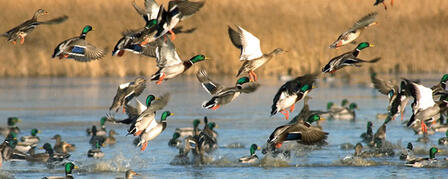WATERFOWL HUNTING SEASON LOOKS PROMISING AFTER RECENT RAINS

Aug. 8, 2013
Wildlife area managers are optimistic waterfowl hunters will enjoy a high-quality season
PRATT– Get your decoys in order, your waders patched and your retriever in shape. The upcoming waterfowl season could be fantastic. After enduring more than two years of severe drought, Kansas Department of Wildlife, Parks and Tourism (KDWPT) wildlife area managers are preparing to welcome both waterfowl and hunters this fall. Couple that good news with reports of high numbers of waterfowl on the nesting grounds, liberal season length frameworks and increased bag limits on several species (six teal during early teal season and six Canada geese), and you have a recipe for a great hunting season.
Several of Kansas’ top waterfowl hunting wetlands, including Cheyenne Bottoms, Jamestown, Marais des Cygnes, McPherson and Neosho wildlife areas, have benefitted from recent rains. Below are reports from KDWPT wildlife area managers.
Cheyenne Bottoms Wildlife Area
“We have gone from completely dry to having the prospects of an excellent waterfowl season this fall,” said Cheyenne Bottoms Wildlife Area manager Karl Grover. “Recent rains have provided run off in the Dry Creek and Wet Walnut Creek drainages, which we have been able to divert to the wildlife area.”
Local run-off has Pool 5 flooded to the south with overflow going into the closed outlet canal and Pool 4B via low water crossings. The pump station at the east hub is currently placing water from 5 into Pool 1A.
Blood and Deception creeks are flowing near full into Pool 2, which has about 12 inches of water. Pools 3A and 3B both have about 6 inches. As Pool 2 fills to 18 inches, excess water will be placed into Pool 3A/3B. Pool 4A has about 7 inches of water and will begin receiving water from Pool 4B. Diverted water from the Wet Walnut and Dry Creek is being placed into Pools 1A, 1B, 1C and 2.
“With the good waterfowl production this year, good water at the Bottoms, and some very good food production in the marsh, we are hoping for one of the best duck and goose seasons in some time” said Grover.
Jamestown Wildlife Area
“All wetlands are flooding,” said Jamestown Wildlife Area manager Rob Unruh. “We were preparing to pump some of our smaller wetlands, but now we don’t have to.”
Unruh added that last Friday alone, Jamestown Wildlife Area received as much as 6-8 inches of rain.
“Moist soil habitat was excellent prior to the flooding and corn was coming along nicely,” said Unruh. “Now, we will need to lose some of this water in the next two days to recover some of the habitat.”
Unruh added that staff plans to save some of the excess water at lower elevations and supplement those marshes with water from the Gamekeeper Marsh later in the season.
“Regardless, we are optimistic about the prospects for a great waterfowl season,” said Unruh.
Marais des Cygne Wildlife Area
“After going over 50 days with no rain, we have had a little over 3 inches in the last week alone,” said Marais des Cygnes Wildlife Area manager Karl Karrow. “A few acres of corn were planted by production farmers or duck clubs this year, and those that were planted on duck clubs were planted late enough that they may now be encountering saturated soils.”
“The clubs that rely on moist-soil management will be a mixed bag,” said Karrow, “but this rain should help.”
Although recent rains aren’t enough to create excellent waterfowl hunting conditions for the upcoming season, Karrow says Marais des Cygnes’ habitat conditions have improved.
“We have ponded a little water in some pools, so there’s definitely a possibility of conditions improving even further,” Karrow added.
McPherson Valley Wetlands
“The McPherson Valley Wetlands are all but full,” said area manager Brent Theede. “In fact, all hunting pools in all three units (Big Basin, Chain of Lakes, and Farland Lake) are full or even over flowing at this point.”
Overall, it appears the McPherson Valley Wetlands are living up to their name and duck hunters should enjoy some quality hunting here.
Neosho Wildlife Area
Area manager Monte Manbeck said Neosho Wildlife Area has had a rough start this year. He explained that corn was planted the first time in late May, but 5 inches of rainfall in a two-day span following planting washed out the pools. After water was drained, staff replanted in late June. Little to no precipitation caused moist soil plants to struggle and the corn wasn’t growing, so staff grew concerned. Now, Manbeck says the area has had over 10 inches of rain in the last 10 days.
“It is either feast or famine around here it seems,” says Manbeck. “Although it is still too early to tell how the corn will do, moist soil food production will be good to excellent this year.”
Manbeck said water conditions for the area and surrounding landscape in southeast Kansas look very favorable for fall.
“Private ponds, Wetland Reserve Program lands and the refuge are all near full or are running over emergency spillways,” said Manbeck. “These conditions coupled with the predicted fall flight forecast should make for a very good early teal season, as well as a good regular waterfowl season for those who hunt in southeast Kansas.”
For a complete list of areas open for waterfowl hunting, visit ksoutdoors.com and click “Hunting/Where to Hunt in Kansas.”
-30-







